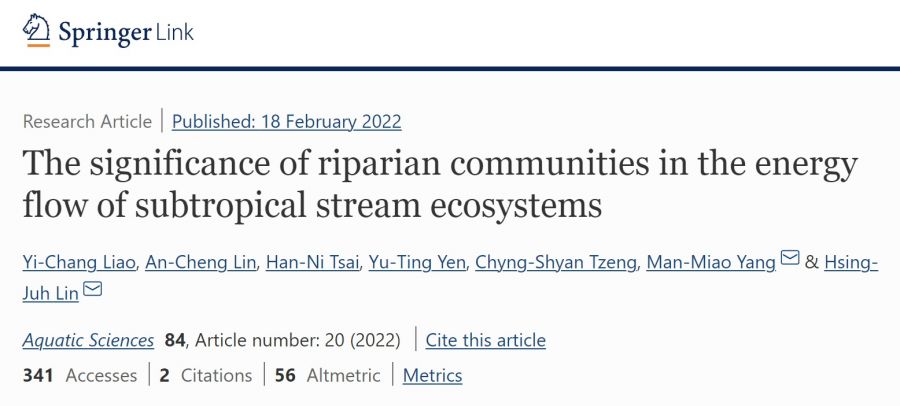生態農業:農業溫室氣體減量【生命科學系/林幸助特聘教授】
| 論文篇名 | The significance of riparian communities in the energy flow of subtropical stream ecosystems |
| 期刊名稱 | AQUATIC SCIENCES |
| 發表年份,卷數,起迄頁數 | 2022, 84, 20 |
| 作者 | Liao, Yi-Chang; Lin, An-Cheng; Tsai, Han-Ni; Yen, Yu-Ting; Tzeng, Chyng-Shyan; Yang, Man-Miao*; Lin, Hsing-Juh(林幸助)* |
| DOI | 10.1007/s00027-022-00850-x |
| 中文摘要 | 臺灣溪流生態研究新突破!中興大學與清華大學跨校團隊歷經1年的生態調查,完成國內少見橫跨水域、濱溪陸域的生態系研究,以苗栗後龍溪流域為樣區,建構食物網模式及分析生態數據,研究發現昆蟲等節肢動物在食物鏈中扮演的重要角色。成果2022年2月刊登於國際水域生態知名期刊《Aquatic Sciences》,未來可作為溪流保育之參考。此項研究涵蓋的生物類群共分為25個生態功能群,包含微藻、碎屑、昆蟲、甲殼類、魚類、兩棲類、肉食哺乳動物、陸域植被,各種生態數據由中興大學生命科學系林幸助特聘教授、中興大學昆蟲系楊曼妙教授、清華大學曾晴賢教授團隊、中興大學昆蟲系廖一璋博士分工蒐集,最後再由廖一璋及林幸助進行數據整合,並建構出溪流的生態系統模式。 臺灣有超過100多條主要溪流,溪流保育為極需重視的議題,相較於高山溪流,淺山溪流與貼近人民生活,也更易受人為活動汙染。過去溪流保育工作常著重在水域生物,甚少全面考量包含濱溪陸域的整個生態系統,比如多樣性極高的昆蟲等節肢動物也時常被忽略。此項研究突破之處,在於系統化且完整地探究濱溪生物群聚,在溪流生態系統中所扮演的角色。林幸助表示,建構食物網模式可將複雜的生態系結構及功能簡化,以摘要的方式來描述生態系,有助於科學家瞭解生態系統的運作及特性。研究結果突顯昆蟲等節肢動物,在溪流生態系統中扮演著水域及陸域之間能量傳遞的重要角色,許多水域及陸域生物皆以昆蟲為主要食物來源。針對濱溪植被豐富之溪流,若將陸域群聚移除,則將對生態模式結構有顯著影響。由此可見,濱溪陸域及水域應視為一個完整且不可分割的生態系統。廖一璋指出,昆蟲就像生態工程師一般,鞏固著其中的能量橋梁,透過食物鏈之網絡,使水域及陸域之間的能量流循環不息,進而促進溪流生態系統之成熟及穩定性。楊曼妙認為,昆蟲在自然界中較不起眼,常不被重視,但本研究證實昆蟲在溪流生態系統中不可忽視的地位。林幸助表示,本研究是以較系統性的研究方式來提出客觀的科學證據,顯示溪流整治工作若採用水泥作邊坡化等工程移除濱岸植被,其實對於整個溪流生態系統會有不可逆的巨大影響,希望能藉此讓相關管理當局對於未來溪流保育政策上能納入濱溪陸域環境生態之考量。 |
| 英文摘要 | There is a frequent energy fow connection between streams and riparian zones. However, riparian communities have been limited in studies of stream ecosystems. To understand the signifcance of riparian communities in the energy fow of stream ecosystems, we compared two trophic models in a small forest tributary (the Feifong Stream) and the mainstream (the Houlong Stream) that possessed high and low biomasses of riparian vegetation and arthropods, respectively. There were 25 functional groups classifed into 3 integer trophic levels in the two trophic models. Arthropods, mostly insects, were the main carrier of the energy fow between aquatic and riparian habitats. The feeding connections were more extensive and intensive in the tributary than in the mainstream, as riparian arthropods were more abundant in the tributary. When including the ripar‑ ian community in the tributary, the trophic model became more mature, as the values of system omnivory index and trophic transfer efciency and the ascendency: capacity ratio were higher, but the connectance index value and overhead: capacity ratio were lower in the model with riparian groups than in the model without riparian groups. In the tributary, the ecotrophic efciency (EE) values of aquatic insect groups increased largely if the riparian community was included in the model. In the mainstream, however, most of the ecosystem attributes and the EE values of aquatic insect groups did not obviously change if the model included the riparian community. This study highlights the signifcance of riparian communities in the energy fow of subtropical stream ecosystems. Aquatic and riparian systems should be considered together as a mature ecosystem for the planning of stream conservation. The loss or degradation of one habitat may have more detrimental efects on the other community than we have previously recognized, particularly in a small forest stream. |
| 發表成果與本中心研究主題相關性 | 利用生態系模式,探究濱溪生物群聚在溪流生態系統中所扮演的能量傳輸角色 |







